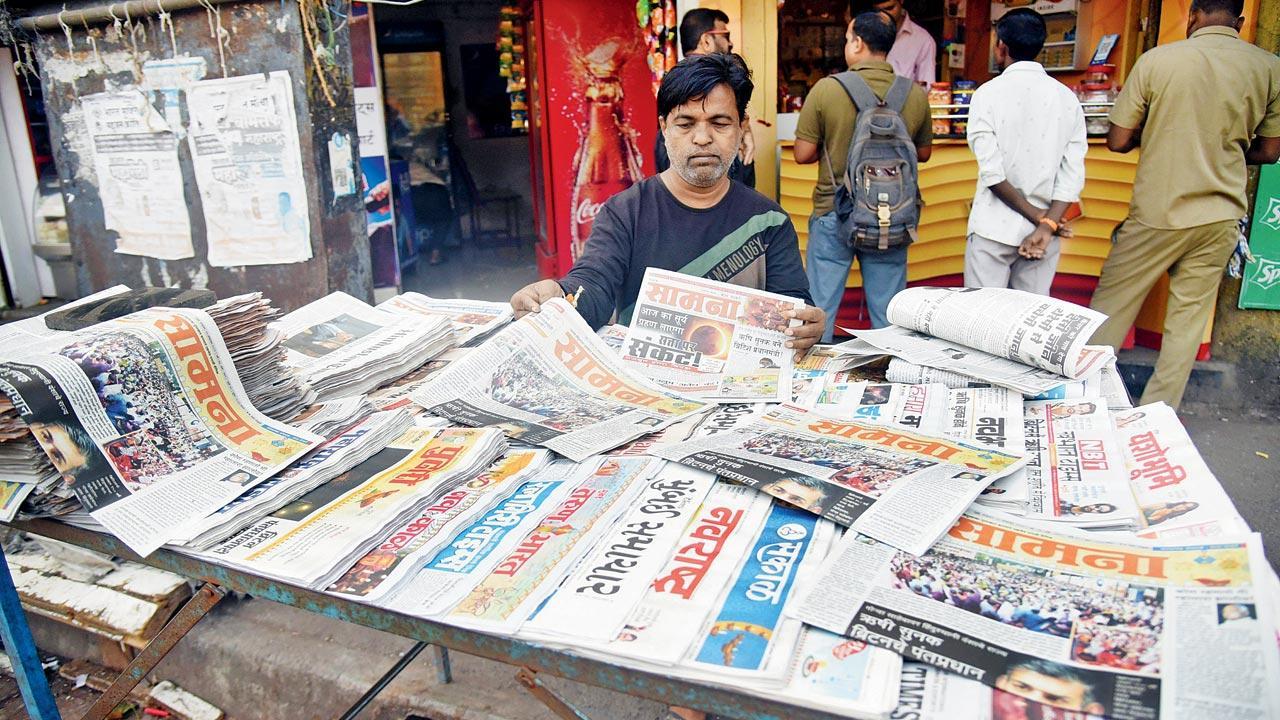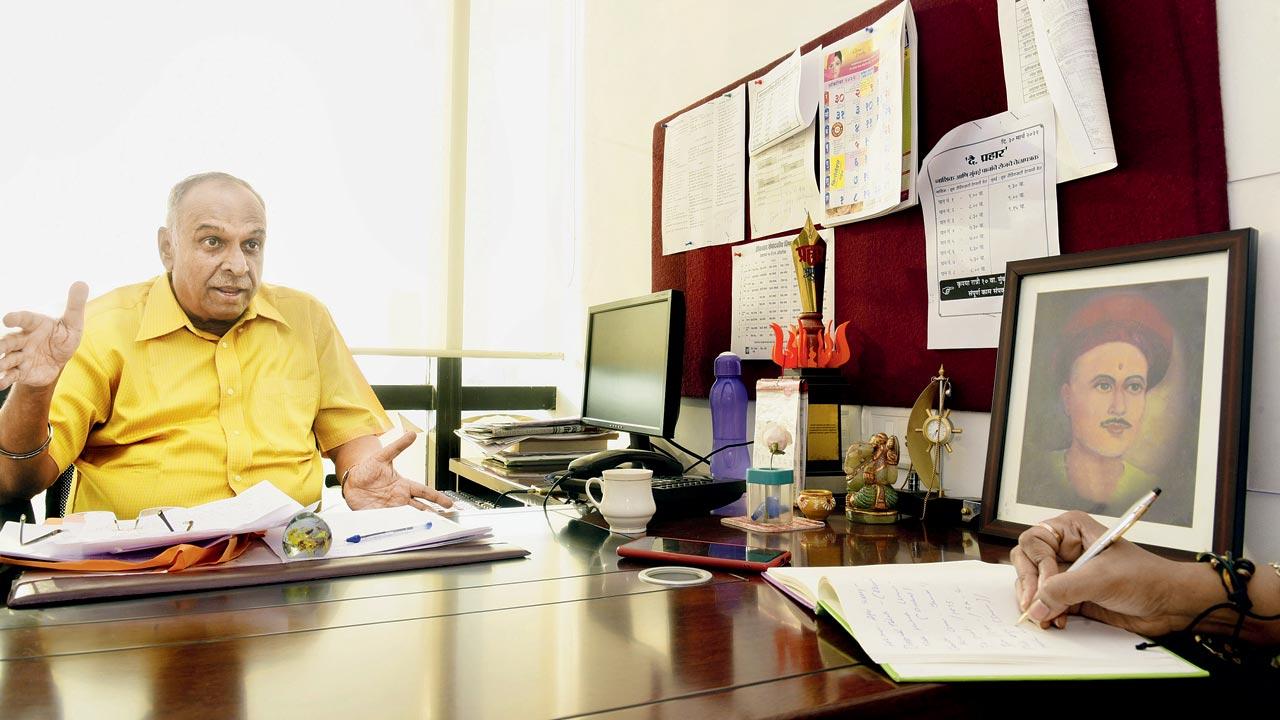A journalist’s PhD dissertation, apparently the first to look at a political party mouthpiece’s influence, traces how it came to represent the identity of a leader and its people so effectively that it influenced many an election

While political parties across the country have their own publications, Khandekar says that none of them wield the influence that Saamana does. “It’s the official gazette, voice and face of the party, reflecting the party’s opinion about current affairs, as well as the government,” he says. Pic/Atul Kamble
Three months shy of completing 50 years as a journalist, Mumbai-based Dr Sukrit Khandekar who is editor of the Marathi newspaper Prahar, continues to be a diligent student and pursuer of the subject that shaped his career. Having acquired a Masters degree in journalism in 2008, nearly 33 years after he graduated in the same, he was recently awarded a PhD from the Department of Mass Communication from Pune’s Tilak Maharashtra Vidyapeeth.
The inspiration, the 71-year-old admits, came from his contemporary, Dr Bharat Kumar Raut. The veteran journalist like Khandekar, did his PhD on the Bhagavad Gita. He was later egged on by his classmate Deepak Tilak, the vice chancellor of Tilak Maharashtra Vidyapeeth. It was, however, the research subject that took even him by surprise. Having worked for leading dailies in Maharashtra, in senior editorial roles, including Kesari, Loksatta, Navshakti, The Maharashtra Times, and Lokmat, Khandekar decided to veer off course, focusing his research on the Shiv Sena mouthpiece, Saamana.
ADVERTISEMENT
 A file picture of supporters reading Saamana with the front page news of the demise of Shiv Sena party supremo Bal Thackeray during his funeral procession on November 18, 2012. Pic/Getty Images
A file picture of supporters reading Saamana with the front page news of the demise of Shiv Sena party supremo Bal Thackeray during his funeral procession on November 18, 2012. Pic/Getty Images
When we meet him at his Kalanagar office, Khandekar, who knows Maharashtra’s politics down pat, fetches a pile of regional publications for us. Saamana sits at the top. “This is a very different kind of mouthpiece,” he says. “Parties across the country have their own publications, but none of them wield the influence that Saamana does. It’s one of the most powerful political instruments.”
When Khandekar’s research subject got an approval from the University back in 2018, he remembers reaching out to Shiv Sena chief and Saamana editor, Uddhav Thackeray over a phone call. “I needed access to the archives and material on the publication’s genesis and history. My interest was mainly on the impact that Saamana had on the party, and influencing corporation, state and legislative assembly elections.” He explains why this matters.
 Dr Sukrit Khandekar
Dr Sukrit Khandekar
“Before Balasaheb Thackeray launched Shiv Sena in 1966, he started the Marathi weekly Marmik [1960]. That publication united the Maharashtrians... its popularity compelled him to create a sangathan. And that’s why he launched his party. But, back then, the party’s Marathi manoos agenda got a lot of negative publicity, especially from leading English and Marathi dailies, who termed it an organisation of goons. Sensing the lack of support, Thackeray thought of establishing his own paper, which would convey the party’s and his own point of view clearly to the people. Maharashtrians were already feeling exploited and believed that they were being given second-class treatment by the ‘outsiders.’ With Saamana launching on January 23, 1989 [Bal Thackeray’s birthday], he was able to give vent to their feelings of displeasure. It became the official gazette, voice and face of the party, reflecting the party’s opinion about current affairs, as well as the government,” says Khandekar. The idea for the name came from a popular Marathi drama, Saamana, which released in 1974. “That stayed with him, and he decided to name his publication after it.” Incidentally, the name had already been registered by someone in Nasik. “Balasaheb convinced that person to allow him to use it.”
The launch of the publication also coincided with the Sena’s growing importance in the state’s political scene. “In 1984, Sena joined hands with the BJP and took on the Hindutva agenda. This got it support even from non-Marathis in Maharashtra.” Nearly a decade later, they went on to win the Mumbai municipal elections, and have since held fort there.
Khandekar claims that during research, he found out that this is also the first time that someone has chosen to do a PhD on a political party’s mouthpiece. While Saamana also gets published in Hindi, he has focussed only on the Marathi edition. For his research, he spoke to key party leaders, including Sanjay Raut and Subhash Desai, the karyakartas and shakha members, senior politicians and journalists, as well as general readers of the publication. “Most bureaucrats and party leaders in the ruling government and Opposition dedicatedly read the front page and editorial of the party. Because its messaging is so strong, it can reach far and wide, and have social and political implications. So, more than the Shiv Sainiks, it’s actually those outside [the party] who read the Saamana.” What’s interesting, says Khandekar, is that even when the Sena was in alliance with the BJP in the Assembly, it continued to be critical of the national party in its editorials. “Before 2014, the paper vociferously criticised the Congress and NCP; the Gandhi government, especially. They were their biggest political enemy. But after the Sena and BJP contested the Assembly elections separately in 2014, they began training their guns on the Modi-Shah government.” With Sena officially splitting with BJP in 2019, and joining the Maha Vikas Agadhi with Congress and NCP, the alliance partners are now being spared their fury. “Their aggressive views on Hindutva have also toned down since then,” he feels.
A turning point for the mouthpiece was when the party carried a marathon interview with Sharad Pawar in July 2020. “This was a strong statement. Though the Thackeray family and Pawar have always shared a friendship, something like this would have been unheard of when Balasaheb was around. It was only Balasaheb’s interviews, and later Uddhav’s, which got so much coverage in the paper. This also goes to show that Saamana before Balasaheb and the one after his death, are very different. Today, it’s more a reflection of Uddhav’s ideology and views. But it continues to be aggressive, with a new-found enemy—the Eknath Shinde faction.”
On the basis of what’s being projected in the newspaper currently, Khandekar feels that a reunion of the saffron parties is unlikely, at least in the near future. “The ties have been snapped for good. Today, even the CPI has entry to Matoshree [the Thackeray residence]—this is a historical turn of events. Because, it was Balasaheb who vehemently opposed the Communists.” When MLA Krishna Desai was murdered in Lalbaug on June 5, 1970, Sena supporters were arrested and later convicted.
One of the most stellar and instrumental figures who has given this publication heft, feels Khandekar, is Raut, currently in judicial custody in a money laundering case. “When Sena joined the MVA alliance, Raut’s work through the pieces he brought out in Saamana was stellar.” He convinced Sena followers about the shift and spelled out the party’s line powerfully, feels Khandekar. Raut started out as a journalist with the weekly publication Lokprabha, where Khandekar says, he wrote critical articles against the Sena and Thackeray senior. “But Balasaheb knew Raut’s worth. In 1994, after he had written a piece on the underworld, Balasaheb invited Raut to join him, and he accepted the invitation. He was Balasaheb’s right-hand man. He would go with him wherever he travelled, and he had the ability to pen his speeches and thoughts in an astute manner; people wouldn’t know whether this was Balasaheb or Raut speaking.” While the Enforcement Directorate had claimed that Raut wasn’t allowed to write articles or columns for the Saamana, there have been rumours of him writing under a pen name. Khandekar says Raut was also the chief architect behind Uddhav Thackeray eventually claiming the chief minister’s position.
Saamana’s readership did get affected during the COVID-induced lockdown, but its popularity remains intact, says Khandekar. Having said that, he adds that Saamana should not be seen as a “complete newspaper”. “And the publication makes no bones about that.”
Its readers in numbers
85 per cent
Of Saamana readers surveyed are from urban areas of Maharashtra
49 per cent
Readers surveyed only read Saamana
30mins
Average amount of time people spend daily reading this newspaper
27 per cent
Readers surveyed who only read political news in the paper
 Subscribe today by clicking the link and stay updated with the latest news!" Click here!
Subscribe today by clicking the link and stay updated with the latest news!" Click here!








